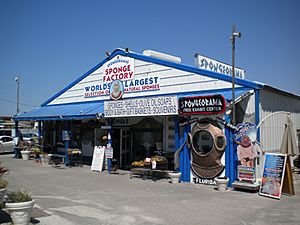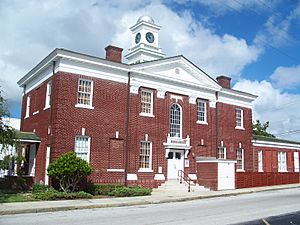Tarpon Springs, Florida facts for kids
Quick facts for kids
Tarpon Springs, Florida
|
|
|---|---|
| City of Tarpon Springs | |
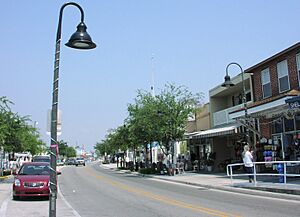
Dodecanese Avenue
|
|
| Motto(s):
Visit Greece Without Leaving Florida
|
|
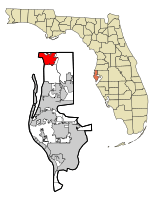
Location in Pinellas County and the state of Florida
|
|
| Country | United States |
| State | Florida |
| County | Pinellas |
| Settled | 1876 |
| Incorporated (city) | 1887 |
| Government | |
| • Type | Commission–Manager |
| Area | |
| • Total | 17.93 sq mi (46.44 km2) |
| • Land | 9.26 sq mi (23.98 km2) |
| • Water | 8.67 sq mi (22.46 km2) |
| Elevation | 23 ft (7 m) |
| Population
(2020)
|
|
| • Total | 25,117 |
| • Density | 2,712.42/sq mi (1,047.31/km2) |
| Time zone | UTC-5 (Eastern (EST)) |
| • Summer (DST) | UTC-4 (EDT) |
| ZIP codes |
34688, 34689
|
| Area code(s) | 727 |
| FIPS code | 12-71150 |
| GNIS feature ID | 0292048 |
Tarpon Springs is a city in Pinellas County, Florida, United States. Downtown Tarpon Springs has long been a focal point and underwent beautification in 2010. It is part of the Tampa Bay area. The population was 25,117 at the 2020 census.
As of 2000, Tarpon Springs had the highest percentage of Greek Americans of any city in the US, with 10.4% of residents who had Greek ancestry.
Contents
History
The region, with a series of bayous feeding into the Gulf of Mexico, was settled by farmers and fishermen around 1876. Some of the newly arrived visitors spotted tarpon jumping out of the waters and so named the location Tarpon Springs. The name is said to have originated with a remark of Mrs. Ormond Boyer, an early settler from South Carolina, and who, while standing on the shore of the Bayou and seeing fish leaping, exclaimed, "See the tarpon spring!' For the most part, the fish seen splashing here were mullet rather than tarpon. In 1882, Hamilton Disston, who in the previous year had purchased the land, ordered the creation of a town plan. On February 12, 1887, Tarpon Springs became the first incorporated city in what is now Pinellas County. Less than a year later on January 13, 1888, the Orange Belt Railway, the first railroad line to be built in what is now Pinellas County, arrived in the city. During this time the area was developed as a wintering spot for wealthy northerners.
The city's Rose Cemetery, where Black residents are interred, is believed to contain burials which began in the late 1800s; the earliest legible marked burial is from 1904. The cemetery contains the grave of Richard Quarls, a Confederate veteran of the American Civil War who fought alongside his enslaver before moving to Tarpon Springs and choosing the new name "Christopher Columbus", and veterans of subsequent wars.
Sponge industry
In the 1880s, John K. Cheyney founded the first local sponge business. The industry continued to grow in the 1890s. Many people from Key West and the Bahamas settled in Tarpon Springs to hook sponges and then process them. A few Greek immigrants also arrived in this city during the 1890s to work in the sponge industry.
In 1905, John Cocoris introduced the technique of sponge diving to Tarpon Springs by recruiting divers and crew members from Greece. The first divers came from the Saronic Gulf islands of Aegina and Hydra, but they were soon outnumbered by those from the Dodecanese islands of Kalymnos, Symi and Halki. The sponge industry soon became one of the leading maritime industries in Florida and the most important business in Tarpon Springs, generating millions of dollars a year. The 1953 film Beneath the 12-Mile Reef, depicting the sponge industry, takes place and was filmed in Tarpon Springs.
In 1947, a red tide algae bloom wiped out the sponge fields in the Gulf of Mexico, causing many of the sponge boats and divers to switch to shrimping for their livelihood, while others left the business. Eventually, the sponges recovered, allowing for a smaller but consistent sponge industry today. In the 1980s, the sponge business experienced a boom due to a sponge disease that killed the Mediterranean sponges. Today there is still a small active sponge industry.
Geography
According to the United States Census Bureau, the city of Tarpon Springs has a total area of 16.9 square miles (44 km2), of which 9.1 square miles (24 km2) is land and 7.7 square miles (20 km2) (45.83%) is water.
Climate
Tarpon Springs' climate borders on humid subtropical and tropical savanna, with warm temperatures year-round, although winter nights are cool. Annual precipitation is around 50 inches (1,300 mm). Winters are warm, with daytime highs of 69 to 72 °F (21 to 22 °C), and nightly lows of 50 to 54 °F (10 to 12 °C). Freezing temperatures (32 °F (0 °C) or lower) occur infrequently, while snowfall is extremely rare; there was accumulation in 1977 and 1989, while the years 1899, 1954, 1958, 1973, 2001, 2006, 2010, and 2014 either saw light snow mixed with rain, or flurries. The record low temperature of 19 °F (−7 °C) was observed on four different dates: December 1, 1962, December 13, 1962, December 14, 1962, and January 13, 1985. Summers are hot and very humid, causing frequent afternoon thunderstorms that can occasionally produce hail, and, even tornadoes or waterspouts off the Gulf of Mexico. Daytime temperatures usually range from 89 to 91 °F (32 to 33 °C), with temperatures over 100 °F (38 °C) very rare. The record high temperature of 102 °F (39 °C) was observed on July 10, 1997. Spring and fall are generally warm.
| Climate data for Tarpon Springs, Florida (Tarpon Springs Sewage Plant), 1991–2020 normals, extremes 1892–present | |||||||||||||
|---|---|---|---|---|---|---|---|---|---|---|---|---|---|
| Month | Jan | Feb | Mar | Apr | May | Jun | Jul | Aug | Sep | Oct | Nov | Dec | Year |
| Record high °F (°C) | 90 (32) |
97 (36) |
92 (33) |
95 (35) |
100 (38) |
100 (38) |
102 (39) |
99 (37) |
99 (37) |
96 (36) |
93 (34) |
89 (32) |
102 (39) |
| Mean maximum °F (°C) | 81.7 (27.6) |
82.5 (28.1) |
85.9 (29.9) |
89.4 (31.9) |
92.4 (33.6) |
94.8 (34.9) |
95.3 (35.2) |
95.3 (35.2) |
94.0 (34.4) |
90.5 (32.5) |
86.1 (30.1) |
82.4 (28.0) |
96.4 (35.8) |
| Mean daily maximum °F (°C) | 69.3 (20.7) |
72.0 (22.2) |
76.0 (24.4) |
81.1 (27.3) |
86.2 (30.1) |
89.7 (32.1) |
90.6 (32.6) |
90.8 (32.7) |
88.9 (31.6) |
83.8 (28.8) |
76.3 (24.6) |
71.4 (21.9) |
81.4 (27.4) |
| Daily mean °F (°C) | 60.0 (15.6) |
62.9 (17.2) |
66.8 (19.3) |
72.2 (22.3) |
77.6 (25.3) |
82.0 (27.8) |
83.1 (28.4) |
83.3 (28.5) |
81.3 (27.4) |
75.6 (24.2) |
67.5 (19.7) |
62.4 (16.9) |
72.9 (22.7) |
| Mean daily minimum °F (°C) | 50.7 (10.4) |
53.8 (12.1) |
57.6 (14.2) |
63.2 (17.3) |
69.1 (20.6) |
74.4 (23.6) |
75.6 (24.2) |
75.7 (24.3) |
73.6 (23.1) |
67.3 (19.6) |
58.6 (14.8) |
53.5 (11.9) |
64.4 (18.0) |
| Mean minimum °F (°C) | 32.9 (0.5) |
36.9 (2.7) |
42.0 (5.6) |
50.1 (10.1) |
59.6 (15.3) |
68.4 (20.2) |
70.6 (21.4) |
71.9 (22.2) |
66.9 (19.4) |
53.3 (11.8) |
42.7 (5.9) |
37.2 (2.9) |
30.8 (−0.7) |
| Record low °F (°C) | 19 (−7) |
20 (−7) |
23 (−5) |
34 (1) |
45 (7) |
51 (11) |
62 (17) |
63 (17) |
53 (12) |
38 (3) |
26 (−3) |
19 (−7) |
19 (−7) |
| Average precipitation inches (mm) | 3.03 (77) |
2.51 (64) |
3.08 (78) |
2.69 (68) |
2.35 (60) |
7.06 (179) |
9.05 (230) |
9.66 (245) |
7.03 (179) |
3.19 (81) |
1.90 (48) |
2.74 (70) |
54.29 (1,379) |
| Average precipitation days (≥ 0.01 in) | 9.0 | 7.4 | 7.6 | 6.1 | 6.2 | 11.3 | 15.7 | 16.2 | 12.7 | 7.5 | 5.6 | 6.7 | 112.0 |
| Source: NOAA | |||||||||||||
Demographics
| Historical population | |||
|---|---|---|---|
| Census | Pop. | %± | |
| 1890 | 327 | — | |
| 1900 | 541 | 65.4% | |
| 1910 | 2,212 | 308.9% | |
| 1920 | 2,105 | −4.8% | |
| 1930 | 3,414 | 62.2% | |
| 1940 | 3,402 | −0.4% | |
| 1950 | 4,323 | 27.1% | |
| 1960 | 6,768 | 56.6% | |
| 1970 | 7,118 | 5.2% | |
| 1980 | 13,251 | 86.2% | |
| 1990 | 17,906 | 35.1% | |
| 2000 | 21,003 | 17.3% | |
| 2010 | 23,484 | 11.8% | |
| 2020 | 25,117 | 7.0% | |
| U.S. Decennial Census | |||
2010 and 2020 census
| Race | Pop 2010 | Pop 2020 | % 2010 | % 2020 |
|---|---|---|---|---|
| White (NH) | 19,531 | 19,804 | 83.17% | 78.85% |
| Black or African American (NH) | 1,437 | 1,524 | 6.12% | 6.07% |
| Native American or Alaska Native (NH) | 50 | 56 | 0.21% | 0.22% |
| Asian (NH) | 331 | 360 | 1.41% | 1.43% |
| Pacific Islander or Native Hawaiian (NH) | 19 | 16 | 0.08% | 0.06% |
| Some other race (NH) | 48 | 131 | 0.20% | 0.52% |
| Two or more races/Multiracial (NH) | 361 | 944 | 1.54% | 3.76% |
| Hispanic or Latino (any race) | 1,707 | 2,282 | 7.27% | 9.09% |
| Total | 23,484 | 25,117 | 100.00% | 100.00% |
As of the 2020 United States census, there were 25,117 people, 10,971 households, and 6,191 families residing in the city.
As of the 2010 United States census, there were 23,484 people, 9,870 households, and 6,113 families residing in the city.
Arts and culture
Epiphany celebration
Tarpon Springs is known for elaborate religious ceremonies hosted by the St. Nicholas Greek Orthodox Cathedral, part of the Greek Orthodox Church, including the January 6 Epiphany, celebration that includes youths diving for a cross and the blessing of the waters and the boats. Since the first Greek immigrants depended on the sea and their boats for their livelihood, their attachment to a religious service centered on requesting divine protection for what used to be a highly risky job can be easily explained.
The celebration attracts Greek Americans from across the country, and the city's population is known to triple in size for that day. The Metropolitan of Atlanta usually presides over the blessings, sometimes joined by the Archbishop of America. The blessings conclude with the ceremonial throwing of a wooden cross into the city's Spring Bayou, and boys ages 16 to 18 dive in to retrieve it: whoever recovers the cross is said to be blessed for a full year.
Tourism
Dodecanese Avenue in the Greektown Historic District of Tarpon Springs is both part of the traditional Greek community and the city's primary tourist destination. The street winds its way from Pinellas Avenue west along the Anclote River. Numerous restaurants serve traditional Greek cuisine and fresh seafood.
The nearby beaches, part of the Pinellas County parks, are popular for water activities. Sandy barrier islands off shore shift position over time with the waves and storms. They are accessible by boat and are especially ideal for shell spotting and watching bottlenose dolphins at play. One permanent island, Anclote Key, is a State Park Preserve with a historic lighthouse, bird nesting colonies and pristine beaches.
The Tarpon Springs Heritage Museum in Craig Park offers a permanent exhibition about the history and culture of the Greek Community. The Cultural Center at 101 W. Pinellas Avenue has a changing roster of exhibits about local and regional traditional culture. The Safford House Museum on Parkin Court is a historical house museum that tells the fascinating story of one of the city's early families. The Depot Museum on Tarpon Avenue provides an overview of Tarpon Springs history. The Tarpon Springs Performing Arts Center is a 300-seat theater located inside of historic City hall, 324 Pine Street, and operates year-round bringing an array of nationally touring artists, musicians, dancers, etc. as well as a variety of community theatre plays featuring local actors and directors.
Historic sites
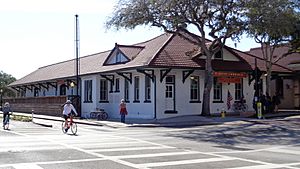
There are several districts or properties in Tarpon Springs that have been listed on the National Register of Historic Places:
- Tarpon Springs Greektown Historic District
- Tarpon Springs Historic District
- Cycadia Cemetery
- Arcade Hotel
- Old Tarpon Springs City Hall
- Old Tarpon Springs High School
- Safford House
- Rose Hill Cemetery
- Tarpon Springs Depot
Many sites related to the sponge industry within the Greektown Historic District also have been recognized. They include but are not limited to two sponge packing houses:
- E.R. Meres Sponge Packing House
- N.G. Arfaras Sponge Packing House
And boats:
- N.K. Symi/Tarpon Springs (Sponge Diving Boat)
- Apalachicola (Sponge Diving Boat)
- Anastasi (Sponge Diving Boat)
Library
The Tarpon Springs Public Library is the public library that services Tarpon Springs, Pinellas, and the greater Tampa Bay area. The library was founded in 1916 Julia Roswell Smith Inness who was the daughter of the owner of the Century Publishing Company.
Over the course of its history, the Tarpon Springs Public Library has called many places home. Originally taking residence in City Hall, the library then moved into a small house on Orange Street in 1921. From there, the library then moved to Pinellas Avenue and then to Library Lane in 1937 when a new building was constructed. As the surround population began to grow, the library made yet another move in 1967 to a building located on Spring Bayou. By this time, the library earned support from the city and eventually enlarged the building from 3,000 to 9,000 square feet in 1986. Less than ten years later, the Tarpon Springs population grew and additional space was needed. In January of 1997, a new 20,000 square foot building officially opened in the middle of the downtown area.
The library is a member of the Pinellas Public Library Cooperative.
Media
Tarpon Springs is the setting and primary filming location of the 1953 film Beneath the Twelve-Mile Reef which follows the lives of a family of Greek sponge fishermen and depicts the annual Epiphany celebration.
Infrastructure
The Tarpon Springs Police Department has 57 sworn officers. Of those, approximately 32 are assigned to the patrol division.
Healthcare
The only hospital in Tarpon Springs is AdventHealth North Pinellas.
Notable people from Tarpon Springs
- 2 Pistols, rapper
- Doug Ault, former professional baseball player, Texas Rangers and Toronto Blue Jays
- Michael Bilirakis, former U.S. Representative
- Gus Bilirakis, U.S. Representative
- Chris Coghlan, former professional baseball player
- Mason Cole, former professional football player, Arizona Cardinals, Minnesota Vikings, and Pittsburgh Steelers
- Dieselboy, electronic music artist
- Billy "The Kid" Emerson, preacher and former rock and roll pianist and songwriter
- Michael Koulianos, preacher, writer and YouTuber
- Elaine Esposito, former record holder of the longest coma
- Wayne Fontes, former NFL coach for the Detroit Lions
- Bertie Higgins, singer of "Key Largo"
- William W. Kingsbury, United States House of Representatives, territorial delegate from Minnesota Territory
- Themistocles Leftheris, 2006 Olympian (with Naomi Nari Nam) in pairs figure skating
- Lois Lenski, Newbery Medal-winning children's author
- Melanie Safka, singer-songwriter
- Savatage, heavy metal band and precursor to Trans-Siberian Orchestra
- Artavis Scott, wide receiver for the Los Angeles Chargers
Sister cities
In 2007 and 2008, the City of Tarpon Springs established Sister City relationships with Kalymnos, Halki, Symi, Hydra, and Larnaca, Cyprus, honoring the close historical link with these Greek-speaking islands.
See also
 In Spanish: Tarpon Springs para niños
In Spanish: Tarpon Springs para niños




